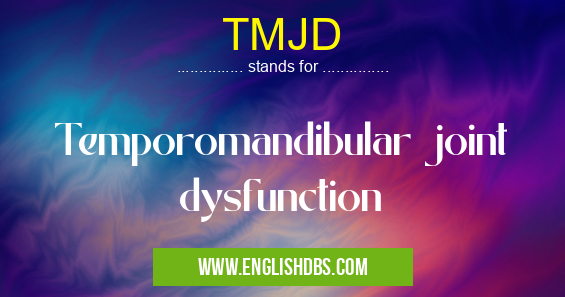What does TMJD mean in NURSING
TMJD stands for Temporomandibular Joint Dysfunction, a condition that affects the temporomandibular joint (TMJ). The TMJ is a hinge joint that connects the jawbone to the skull, allowing for movement of the jaw during functions such as talking, eating, and yawning.

TMJD meaning in Nursing in Medical
TMJD mostly used in an acronym Nursing in Category Medical that means Temporomandibular joint dysfunction
Shorthand: TMJD,
Full Form: Temporomandibular joint dysfunction
For more information of "Temporomandibular joint dysfunction", see the section below.
What is TMJD?
TMJD is a complex condition that can cause a variety of symptoms, including:
- Jaw pain
- Clicking or popping sounds in the jaw
- Difficulty opening or closing the mouth
- Facial pain
- Headaches
- Earaches
TMJD can be caused by a number of factors, including:
- Misalignment of the jaw
- Muscle tension in the jaw
- Arthritis
- Injury to the TMJ
- Stress
Diagnosis and Treatment
Diagnosing TMJD typically involves a physical examination of the jaw and a discussion of symptoms. Imaging tests, such as X-rays or MRI scans, may be used to rule out other potential causes of the symptoms.
Treatment for TMJD may include:
- Medications to relieve pain
- Physical therapy to strengthen muscles and improve range of motion
- Occlusal splints to correct misalignment of the jaw
- Surgery in severe cases
Essential Questions and Answers on Temporomandibular joint dysfunction in "MEDICAL»NURSING"
What is TMJD?
TMJD (Temporomandibular Joint Dysfunction) is a condition that causes pain and dysfunction in the temporomandibular joint (TMJ), which connects your jaw to your skull.
What are the symptoms of TMJD?
Symptoms of TMJD can include pain in the jaw, face, or ears; clicking or popping sounds when opening or closing the mouth; difficulty chewing or biting; and limited jaw movement.
What causes TMJD?
The exact cause of TMJD is unknown, but it's thought to be caused by a combination of factors, including genetics, injury to the jaw, teeth grinding (bruxism), and stress.
How is TMJD diagnosed?
To diagnose TMJD, your doctor will ask about your symptoms and perform a physical examination of your jaw and mouth. They may also order imaging tests, such as X-rays or MRI, to rule out other conditions.
How is TMJD treated?
The treatment for TMJD depends on the severity of your symptoms. Treatment may include self-care measures, such as applying ice or heat to the jaw, eating soft foods, and avoiding activities that aggravate your symptoms. Your doctor may also recommend physical therapy, medications, or a custom-made mouthguard to help reduce pain and improve jaw function.
Can TMJD be prevented?
There is no sure way to prevent TMJD, but there are some things you can do to reduce your risk, such as avoiding chewing gum or hard candy, not grinding your teeth, and managing stress.
Final Words: TMJD is a common condition that can cause significant pain and discomfort. By understanding the causes, symptoms, and treatment options for TMJD, individuals can take steps to manage their condition and improve their quality of life.
TMJD also stands for: |
|
| All stands for TMJD |
